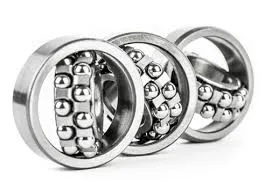
10 月 . 20, 2024 11:06 Back to list
thrust bearing load direction
Understanding Thrust Bearing Load Direction
Thrust bearings play a crucial role in various mechanical systems by enabling them to handle axial loads, or forces that act in a direction parallel to the axis of the bearing. Understanding the load direction in thrust bearings is essential for the proper operation and longevity of machinery. This article explores the fundamental concepts behind thrust bearing load direction, its significance, and the implications for design and application.
What is a Thrust Bearing?
A thrust bearing is a type of rotary bearing that supports axial loads, allowing for rotation while minimizing friction between moving parts. Unlike radial bearings, which support loads perpendicular to the shaft, thrust bearings are designed specifically to withstand thrust loads. These rotary bearings come in various designs, including ball thrust bearings, roller thrust bearings, and fluid thrust bearings, each suited for specific applications and load conditions.
Load Direction in Thrust Bearings
The load direction in thrust bearings is defined by the axial force acting on the bearing. Axial loads can arise from various sources, such as gear trains, turbines, and other rotating machinery that exert forces along the axis of rotation. Proper management of these loads is critical as excessive or improper loading can lead to premature wear, overheating, or failure of the bearing.
Thrust bearings can be categorized into two primary load directions unidirectional and bidirectional. Unidirectional thrust bearings can only handle axial loads in one direction. In contrast, bidirectional thrust bearings are capable of accommodating loads from both directions, making them versatile for applications where reversing loads occurs frequently.
Importance of Load Direction
Understanding load direction is vital for several reasons
thrust bearing load direction

1. Design Considerations When designing a system that incorporates thrust bearings, engineers must consider the expected load directions. This includes determining whether to use unidirectional or bidirectional bearings based on the application’s requirements. Incorrect selection can lead to bearing failure and costly downtime.
2. Life Expectancy The direction and magnitude of the load affect the bearing's life. Manufacturers often provide a load rating for thrust bearings, indicating the maximum load that can be consistently applied without causing failure. Operating beyond the specified load limits in any direction can result in significantly reduced service life.
3. Lubrication The load direction also influences lubrication requirements. Depending on the load applied, different lubrication methods may be needed to ensure proper performance. For instance, high axial loads may require more frequent lubrication to reduce friction and wear.
4. Thermal Management Axial loads generate heat due to friction within the bearing. Understanding load direction helps in effective thermal management of the system. Bearings under consistent high loads must be monitored for temperature, as excessive heat can lead to lubricant breakdown and bearing failure.
Applications of Thrust Bearings
Thrust bearings are widely used in several applications, including
- Automotive Engines In engines, thrust bearings maintain the position of components like the crankshaft against the engine block, particularly during acceleration and deceleration. - Industrial Machinery Equipment such as pumps, compressors, and conveyors incorporate thrust bearings to manage axial loads during operation, ensuring stable and efficient performance. - Aerospace In aerospace applications, thrust bearings are critical in propulsion systems, where precise load handling is essential for safety and efficiency.
Conclusion
Understanding thrust bearing load direction is paramount for engineers and technicians involved in designing and maintaining machinery. Proper selection and application of thrust bearings not only enhance performance but also ensure the reliability and longevity of mechanical systems. As technology advances, ongoing research into bearing materials and designs will continue to improve how thrust bearings manage load direction, pushing the boundaries of efficiency and durability in various industries.
Latest news
-
Unlocking Efficiency with Spherical Roller Bearings
NewsOct.29,2024
-
The Ultimate Guide to Thrust Ball Bearings
NewsOct.29,2024
-
The Power of Thrust Roller Bearings: Engineered for Excellence
NewsOct.29,2024
-
The Power of Deep Groove Ball Bearings for Your Application Needs!
NewsOct.29,2024
-
The Power and Performance of Cylindrical Roller Bearings
NewsOct.29,2024
-
High-Quality Ball Bearing Manufacturing Machines
NewsOct.29,2024
